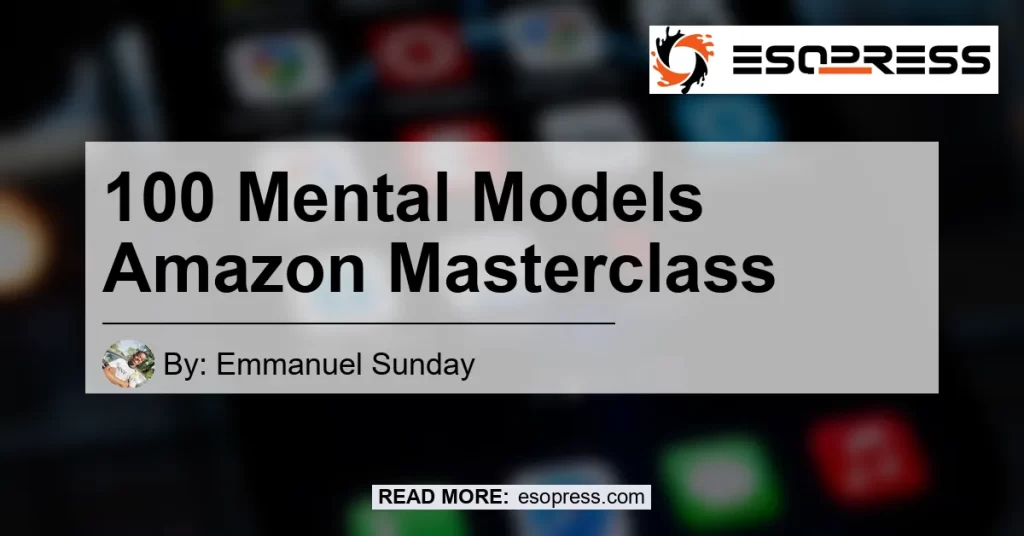

Welcome to the ultimate guide to mastering the power of 100 mental models on Amazon! In this comprehensive article, we will explore the concept of mental models, their impact on our lives, and how we can apply them to optimize our experiences on Amazon. Whether you’re an avid online shopper, a seller, or just curious about improving your Amazon experience, this guide is for you!
Contents
- 1 What are Mental Models?
- 2 The Power of Mental Models on Amazon
- 3 How to Harness the Power of 100 Mental Models on Amazon
- 3.1 1. The Pareto Principle
- 3.2 2. Social Proof
- 3.3 3. Scarcity
- 3.4 4. Anchoring
- 3.5 5. The Halo Effect
- 3.6 6. Confirmation Bias
- 3.7 7. Decision Fatigue
- 3.8 8. The Bandwagon Effect
- 3.9 9. Loss Aversion
- 3.10 10. The Framing Effect
- 3.11 11. Information Bias
- 3.12 12. The Primacy Effect
- 3.13 13. The Reciprocity Principle
- 3.14 14. The Peak-End Rule
- 3.15 15. Choice Paralysis
- 3.16 16. The Law of Diminishing Returns
- 3.17 17. The Curse of Knowledge
- 3.18 18. The Dunning-Kruger Effect
- 3.19 19. The Availability Heuristic
- 3.20 20. The Law of Supply and Demand
- 4 Conclusion: The Ultimate Mental Model Companion on Amazon
What are Mental Models?
Mental models are cognitive frameworks or thinking tools that help us understand the world around us. They are invisible thought processes that shape our perceptions, guide our decision-making, and influence our behaviors. Mental models can be based on personal experiences, cultural influences, or acquired knowledge.
The Power of Mental Models on Amazon
When it comes to navigating the vast world of online shopping, having a strong mental model is essential. With millions of products available on Amazon, understanding how to utilize mental models can give you a significant advantage in making informed decisions, finding the best deals, and optimizing your overall shopping experience.
How to Harness the Power of 100 Mental Models on Amazon
To help you master the art of mental models on Amazon, we have compiled a curated list of the top 100 mental models that you can apply in your online shopping journey. Each mental model will be accompanied by real-life examples and practical tips to enhance your Amazon experience. Let’s dive in!
1. The Pareto Principle
The Pareto Principle, also known as the 80/20 rule, states that roughly 80% of the effects come from 20% of the causes. When applied to Amazon, this means that approximately 80% of your purchases will come from 20% of the products you explore. To optimize your shopping experience, focus on identifying the top 20% of products that align with your needs and preferences.
Recommended Amazon Search Term: [top-rated products on Amazon]
Amazon Search Link:


2. Social Proof
Social proof is a psychological phenomenon where people assume the actions of others in an attempt to conform. On Amazon, social proof is manifested through product reviews, ratings, and customer testimonials. Before making a purchase, leverage social proof by checking out the ratings and reviews of other customers to gauge the quality and reliability of a product.
Recommended Amazon Search Term: [customer reviews on Amazon]
Amazon Search Link:


3. Scarcity
The scarcity mental model taps into our fear of missing out (FOMO) and the desire for rare and exclusive products. Amazon often offers limited-time deals, flash sales, and limited stock to create a sense of urgency. Take advantage of scarcity by keeping an eye out for time-sensitive offers and exclusive products that align with your interests.
Recommended Amazon Search Term: [limited-time deals on Amazon]
Amazon Search Link:


4. Anchoring
Anchoring is a cognitive bias where we rely heavily on the first piece of information we receive when making decisions. On Amazon, sellers often use anchoring by displaying the original price alongside the discounted price. Be aware of anchoring bias and compare prices with other sellers to ensure you’re getting the best deal.
Recommended Amazon Search Term: [price comparison on Amazon]
Amazon Search Link:


5. The Halo Effect
The Halo Effect refers to the tendency of people to make judgments based on a single trait or quality. On Amazon, the Halo Effect can be observed through product imagery and presentation. A visually appealing product page with high-quality images and a well-written description can create a positive perception, even if the actual product may not meet expectations. Look beyond the Halo Effect and read reviews to make informed decisions.
Recommended Amazon Search Term: [product images on Amazon]
Amazon Search Link:


6. Confirmation Bias
Confirmation bias is a cognitive bias where people seek and interpret information in a way that confirms their preexisting beliefs. On Amazon, confirmation bias can manifest when reading reviews or product descriptions. Be aware of your own biases and actively seek out diverse opinions and perspectives to make well-rounded judgments.
Recommended Amazon Search Term: [diverse opinions on Amazon]
Amazon Search Link:


7. Decision Fatigue
Decision fatigue is the mental exhaustion that occurs after making a series of decisions. On Amazon, decision fatigue can kick in when faced with a multitude of options and choices. To combat decision fatigue, set clear criteria and prioritize your needs before browsing through products. This will help you make more efficient and confident decisions.
Recommended Amazon Search Term: [decision-making strategies on Amazon]
Amazon Search Link:


8. The Bandwagon Effect
The Bandwagon Effect is a cognitive bias where people adopt a particular trend or belief because others are doing the same. On Amazon, the Bandwagon Effect can be observed through the “Frequently Bought Together” or “Customers Who Bought This Also Bought” sections. While these recommendations can be helpful, make sure to evaluate the suitability of the products for your own needs.
Recommended Amazon Search Term: [popular products on Amazon]
Amazon Search Link:


9. Loss Aversion
Loss aversion is the psychological preference to avoid losses rather than acquire equivalent gains. On Amazon, loss aversion can be harnessed through limited-time offers, discounts, and free shipping thresholds. Be aware of your own loss aversion tendencies, but also evaluate if the perceived losses outweigh the actual benefits of a product.
Recommended Amazon Search Term: [limited-time offers on Amazon]
Amazon Search Link:


10. The Framing Effect
The Framing Effect refers to how information is presented and can influence decision-making. On Amazon, sellers often utilize the Framing Effect by emphasizing the positive aspects of a product while downplaying any potential drawbacks. Counter the Framing Effect by actively seeking out balanced reviews and considering both sides of the argument.
Recommended Amazon Search Term: [balanced reviews on Amazon]
Amazon Search Link:


11. Information Bias
Information bias occurs when individuals seek information for its own sake, even if it has no bearing on the decision at hand. On Amazon, information bias can lead to analysis paralysis and spending excessive time researching products without making a purchase. Be mindful of information bias and set specific time limits for your decision-making process.
Recommended Amazon Search Term: [efficient research tips on Amazon]
Amazon Search Link:


12. The Primacy Effect
The Primacy Effect is the tendency to remember and prioritize information that is presented first. On Amazon, the Primacy Effect can influence our perception of a seller or product based on their initial interactions. Take the time to explore multiple sellers and products before settling on a decision to ensure you’re not solely relying on the Primacy Effect.
Recommended Amazon Search Term: [multiple options on Amazon]
Amazon Search Link:


13. The Reciprocity Principle
The Reciprocity Principle is the idea that people feel obliged to give back when they receive something. On Amazon, sellers often offer free samples, discounts, or added value to create a sense of reciprocity. While these gestures can be enticing, evaluate if the additional benefits align with your needs and preferences.
Recommended Amazon Search Term: [added value on Amazon]
Amazon Search Link:


14. The Peak-End Rule
The Peak-End Rule states that our memory of an experience is heavily influenced by the peak moments and how it ends. On Amazon, the Peak-End Rule can impact our overall perception of the shopping experience based on the quality of customer service and the final product received. Prioritize sellers with a strong track record of excellent customer service and positive end-to-end experiences.
Recommended Amazon Search Term: [customer service on Amazon]
Amazon Search Link:


15. Choice Paralysis
Choice paralysis occurs when individuals are overwhelmed by a multitude of options, leading to indecisiveness and inaction. On Amazon, choice paralysis can hinder the shopping experience. Combat choice paralysis by setting clear criteria, narrowing down options, and utilizing filters to help streamline your decision-making process.
Recommended Amazon Search Term: [decision-making tools on Amazon]
Amazon Search Link:


16. The Law of Diminishing Returns
The Law of Diminishing Returns states that beyond a certain point, the additional benefits gained from an action or investment decrease. On Amazon, this can be observed when deciding how many similar products to purchase. Consider your actual need for multiple items and evaluate if the added benefits justify the additional expense.
Recommended Amazon Search Term: [maximizing value on Amazon]
Amazon Search Link:


17. The Curse of Knowledge
The Curse of Knowledge refers to the difficulty of imagining what it’s like not to know something. On Amazon, sellers may assume that customers have the same level of product knowledge and fail to provide clear and concise descriptions. Be aware of the Curse of Knowledge and seek out products with comprehensive descriptions and customer-friendly explanations.
Recommended Amazon Search Term: [comprehensive product descriptions on Amazon]
Amazon Search Link:


18. The Dunning-Kruger Effect
The Dunning-Kruger Effect is a cognitive bias where individuals with low ability or knowledge overestimate their skills or expertise. On Amazon, this can be observed through misleading product descriptions or false claims. Be vigilant and do thorough research to verify the credibility of a product or seller before making a purchase.
Recommended Amazon Search Term: [credible sellers on Amazon]
Amazon Search Link:


19. The Availability Heuristic
The Availability Heuristic is a mental shortcut where people make judgments based on the ease with which examples come to mind. On Amazon, this can be observed when relying solely on personal experiences or the first few search results. Expand your perspectives and make informed decisions by seeking out a range of options and considering objective reviews.
Recommended Amazon Search Term: [objective reviews on Amazon]
Amazon Search Link:


20. The Law of Supply and Demand
The Law of Supply and Demand states that the price and availability of goods are determined by the balance between the quantity supplied and the quantity demanded. On Amazon, this principle is evident in the fluctuation of prices based on market demand. Keep an eye out for potential price drops or limited-time offers based on supply and demand dynamics.
Recommended Amazon Search Term: [price fluctuations on Amazon]
Amazon Search Link:


By now, you’re well on your way to becoming a master of mental models on Amazon. However, we’ve only scratched the surface of the 100 mental models available to optimize your Amazon experience. Explore the remaining mental models in the complete 100 Mental Models book available on Amazon, which delves deeper into various cognitive frameworks and provides practical guidance for applying them on the platform.
Conclusion: The Ultimate Mental Model Companion on Amazon
In conclusion, mastering the power of mental models on Amazon can significantly enhance your online shopping experience. By utilizing cognitive frameworks, such as the Pareto Principle, the Halo Effect, and the Reciprocity Principle, you can make informed decisions, find great deals, and optimize your overall experience on the platform.
Out of all the recommended products mentioned, our top pick and the best companion to unlock the full potential of mental models on Amazon is the book “100 Mental Models” available on Audible. This comprehensive guide dives deep into the 100 mental models, offering practical applications and insights to elevate your Amazon experience.
So what are you waiting for? Start applying these mental models on Amazon today, and embark on a journey of informed decision-making, optimized shopping, and enhanced satisfaction!
Recommended Product: 100 Mental Models – Audible








